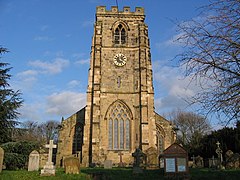Bainton is a village and civil parish in the East Riding of Yorkshire, England. It is situated approximately 6 miles (10 km) south-west of Driffield on the A614 road.
| Bainton | |
|---|---|
 St Andrew's Church, Bainton in 2007 | |
Location within the East Riding of Yorkshire | |
| Population | 334 (2011 census)[1] |
| OS grid reference | SE964522 |
| • London | 170 mi (270 km) S |
| Civil parish |
|
| Unitary authority | |
| Ceremonial county | |
| Region | |
| Country | England |
| Sovereign state | United Kingdom |
| Post town | DRIFFIELD |
| Postcode district | YO25 |
| Dialling code | 01377 |
| Police | Humberside |
| Fire | Humberside |
| Ambulance | Yorkshire |
| UK Parliament | |
According to the 2011 UK census, Bainton parish had a population of 334,[1] an increase on the 2001 UK census figure of 282.[2] The parish covers an area of 1,608.08 hectares (3,973.7 acres).[3]
Bainton was served by Bainton railway station on the Selby to Driffield Line between 1890 and 1954.[4]
Bainton Grade I listed Anglican church is dedicated to St Andrew.[5] Pevsner noted that the church was totally rebuilt in the 1330s or 1340s by the rector William de Brocklesby, except for the south-west corner of the chancel with its priest's doorway, which are c. 1300. Until 1715 the tower supported a spire. The font is Norman, and the pews 18th century. A tomb to Sir Edmund de Mauley lies in the south aisle; [de Mauley, Steward to Edward II, died at the Battle of Bannockburn in 1314]. The tomb has an ogee canopy, crocketed gable and flying angels holding the soul of Sir Edmund in a napkin. There is also a brass to Roger Godeale, died 1429.[6] A south porch and vestry were added by Henry Wheatley in 1843, and a restoration carried out by "Fowler of Louth" in 1866. The church's listed rectory, south of the church, is of late Georgian period. According to Pevsner a local tradition connects the rectory's coniferous garden with Paxton[6][7] The rectory's coach house and stables are also listed buildings.[8]
References
- Gazetteer — A–Z of Towns Villages and Hamlets. East Riding of Yorkshire Council. 2006. p. 3.
External links
 Media related to Bainton at Wikimedia Commons
Media related to Bainton at Wikimedia Commons- Bainton
- Historic England. "Details from listed building database (1083830)". National Heritage List for England.
- Bainton in the Domesday Book




